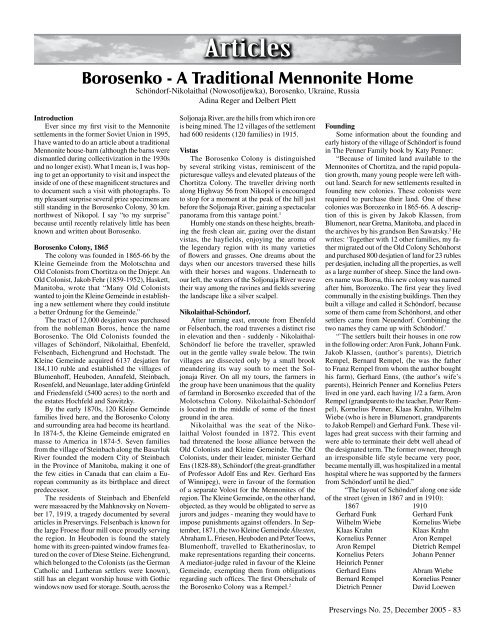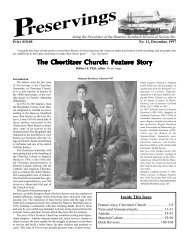Preservings $20 No. 25, December, 2005 - Plett Foundation
Preservings $20 No. 25, December, 2005 - Plett Foundation
Preservings $20 No. 25, December, 2005 - Plett Foundation
Create successful ePaper yourself
Turn your PDF publications into a flip-book with our unique Google optimized e-Paper software.
Articles<br />
Borosenko - A Traditional Mennonite Home<br />
Schöndorf-Nikolaithal (<strong>No</strong>wosofijewka), Borosenko, Ukraine, Russia<br />
Adina Reger and Delbert <strong>Plett</strong><br />
Introduction<br />
Ever since my first visit to the Mennonite<br />
settlements in the former Soviet Union in 1995,<br />
I have wanted to do an article about a traditional<br />
Mennonite house-barn (although the barns were<br />
dismantled during collectivization in the 1930s<br />
and no longer exist). What I mean is, I was hoping<br />
to get an opportunity to visit and inspect the<br />
inside of one of these magnificent structures and<br />
to document such a visit with photographs. To<br />
my pleasant surprise several prize specimens are<br />
still standing in the Borosenko Colony, 30 km.<br />
northwest of Nikopol. I say “to my surprise”<br />
because until recently relatively little has been<br />
known and written about Borosenko.<br />
Borosenko Colony, 1865<br />
The colony was founded in 1865-66 by the<br />
Kleine Gemeinde from the Molotschna and<br />
Old Colonists from Chortitza on the Dnjepr. An<br />
Old Colonist, Jakob Fehr (1859-1952), Haskett,<br />
Manitoba, wrote that “Many Old Colonists<br />
wanted to join the Kleine Gemeinde in establishing<br />
a new settlement where they could institute<br />
a better Ordnung for the Gemeinde.”<br />
The tract of 12,000 desjatien was purchased<br />
from the nobleman Boros, hence the name<br />
Borosenko. The Old Colonists founded the<br />
villages of Schöndorf, Nikolaithal, Ebenfeld,<br />
Felsenbach, Eichengrund and Hochstadt. The<br />
Kleine Gemeinde acquired 6137 desjatien for<br />
184,110 ruble and established the villages of<br />
Blumenhoff, Heuboden, Annafeld, Steinbach,<br />
Rosenfeld, and Neuanlage, later adding Grünfeld<br />
and Friedensfeld (5400 acres) to the north and<br />
the estates Hochfeld and Sawitzky.<br />
By the early 1870s, 120 Kleine Gemeinde<br />
families lived here, and the Borosenko Colony<br />
and surrounding area had become its heartland.<br />
In 1874-5, the Kleine Gemeinde emigrated en<br />
masse to America in 1874-5. Seven families<br />
from the village of Steinbach along the Basavluk<br />
River founded the modern City of Steinbach<br />
in the Province of Manitoba, making it one of<br />
the few cities in Canada that can claim a European<br />
community as its birthplace and direct<br />
predecessor.<br />
The residents of Steinbach and Ebenfeld<br />
were massacred by the Mahknovsky on <strong>No</strong>vember<br />
17, 1919, a tragedy documented by several<br />
articles in <strong>Preservings</strong>. Felsenbach is known for<br />
the large Froese flour mill once proudly serving<br />
the region. In Heuboden is found the stately<br />
home with its green-painted window frames featured<br />
on the cover of Diese Steine. Eichengrund,<br />
which belonged to the Colonists (as the German<br />
Catholic and Lutheran settlers were known),<br />
still has an elegant worship house with Gothic<br />
windows now used for storage. South, across the<br />
Soljonaja River, are the hills from which iron ore<br />
is being mined. The 12 villages of the settlement<br />
had 600 residents (120 families) in 1915.<br />
Vistas<br />
The Borosenko Colony is distinguished<br />
by several striking vistas, reminiscent of the<br />
picturesque valleys and elevated plateaus of the<br />
Chortitza Colony. The traveller driving north<br />
along Highway 56 from Nikopol is encouraged<br />
to stop for a moment at the peak of the hill just<br />
before the Soljonaja River, gaining a spectacular<br />
panorama from this vantage point. 1<br />
Humbly one stands on these heights, breathing<br />
the fresh clean air, gazing over the distant<br />
vistas, the hayfields, enjoying the aroma of<br />
the legendary region with its many varieties<br />
of flowers and grasses. One dreams about the<br />
days when our ancestors traversed these hills<br />
with their horses and wagons. Underneath to<br />
our left, the waters of the Soljonaja River weave<br />
their way among the ravines and fields severing<br />
the landscape like a silver scalpel.<br />
Nikolaithal-Schöndorf.<br />
After turning east, enroute from Ebenfeld<br />
or Felsenbach, the road traverses a distinct rise<br />
in elevation and then - suddenly - Nikolaithal-<br />
Schöndorf lie before the traveller, sprawled<br />
out in the gentle valley swale below. The twin<br />
villages are dissected only by a small brook<br />
meandering its way south to meet the Soljonaja<br />
River. On all my tours, the farmers in<br />
the group have been unanimous that the quality<br />
of farmland in Borosenko exceeded that of the<br />
Molotschna Colony. Nikolaithal-Schöndorf<br />
is located in the middle of some of the finest<br />
ground in the area.<br />
Nikolaithal was the seat of the Nikolaithal<br />
Volost founded in 1872. This event<br />
had threatened the loose alliance between the<br />
Old Colonists and Kleine Gemeinde. The Old<br />
Colonists, under their leader, minister Gerhard<br />
Ens (1828-88), Schöndorf (the great-grandfather<br />
of Professor Adolf Ens and Rev. Gerhard Ens<br />
of Winnipeg), were in favour of the formation<br />
of a separate Volost for the Mennonites of the<br />
region. The Kleine Gemeinde, on the other hand,<br />
objected, as they would be obligated to serve as<br />
jurors and judges - meaning they would have to<br />
impose punishments against offenders. In September,<br />
1871, the two Kleine Gemeinde Ältesten,<br />
Abraham L. Friesen, Heuboden and Peter Toews,<br />
Blumenhoff, travelled to Ekatherinoslav, to<br />
make representations regarding their concerns.<br />
A mediator-judge ruled in favour of the Kleine<br />
Gemeinde, exempting them from obligations<br />
regarding such offices. The first Oberschulz of<br />
the Borosenko Colony was a Rempel. 2<br />
Founding<br />
Some information about the founding and<br />
early history of the village of Schöndorf is found<br />
in The Penner Family book by Katy Penner:<br />
“Because of limited land available to the<br />
Mennonites of Chortitza, and the rapid population<br />
growth, many young people were left without<br />
land. Search for new settlements resulted in<br />
founding new colonies. These colonists were<br />
required to purchase their land. One of these<br />
colonies was Borozenko in 1865-66. A description<br />
of this is given by Jakob Klassen, from<br />
Blumenort, near Gretna, Manitoba, and placed in<br />
the archives by his grandson Ben Sawatsky. 3 He<br />
writes: ‘Together with 12 other families, my father<br />
migrated out of the Old Colony Schönhorst<br />
and purchased 800 desjatien of land for 23 rubles<br />
per desjatien, including all the properties, as well<br />
as a large number of sheep. Since the land owners<br />
name was Borsa, this new colony was named<br />
after him, Borozenko. The first year they lived<br />
communally in the existing buildings. Then they<br />
built a village and called it Schöndorf, because<br />
some of them came from Schönhorst, and other<br />
settlers came from Neuendorf. Combining the<br />
two names they came up with Schöndorf.’<br />
“`The settlers built their houses in one row<br />
in the following order: Aron Funk, Johann Funk.<br />
Jakob Klassen, (author’s parents), Dietrich<br />
Rempel, Bernard Rempel, (he was the father<br />
to Franz Rempel from whom the author bought<br />
his farm), Gerhard Enns, (the author’s wife’s<br />
parents), Heinrich Penner and Kornelius Peters<br />
lived in one yard, each having 1/2 a farm, Aron<br />
Rempel (grandparents to the teacher, Peter Rempel),<br />
Kornelius Penner, Klaas Krahn, Wilhelm<br />
Wiebe (who is here in Blumenort, grandparents<br />
to Jakob Rempel) and Gerhard Funk. These villages<br />
had great success with their farming and<br />
were able to terminate their debt well ahead of<br />
the designated term. The former owner, through<br />
an irresponsible life style became very poor,<br />
became mentally ill, was hospitalized in a mental<br />
hospital where he was supported by the farmers<br />
from Schöndorf until he died.”<br />
“The layout of Schöndorf along one side<br />
of the street (given in 1867 and in 1910):<br />
1867 1910<br />
Gerhard Funk Gerhard Funk<br />
Wilhelm Wiebe Kornelius Wiebe<br />
Klaas Krahn Klaas Krahn<br />
Kornelius Penner Aron Rempel<br />
Aron Rempel Dietrich Rempel<br />
Kornelius Peters Johann Penner<br />
Heinrich Penner<br />
Gerhard Enns Abram Wiebe<br />
Bernard Rempel Kornelius Penner<br />
Dietrich Penner David Loewen<br />
<strong>Preservings</strong> <strong>No</strong>. <strong>25</strong>, <strong>December</strong> <strong>2005</strong> - 83

















